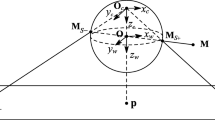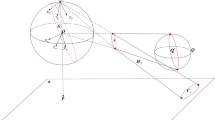Abstract
Catadioptric sensors are devices which utilize mirrors and lenses to form a projection onto the image plane of a camera. Central catadioptric sensors are the class of these devices having a single effective viewpoint. In this paper, we propose a unifying model for the projective geometry induced by these devices and we study its properties as well as its practical implications. We show that a central catadioptric projection is equivalent to a two-step mapping via the sphere. The second step is equivalent to a stereographic projection in the case of parabolic mirrors. Conventional lens-based perspective cameras are also central catadioptric devices with a virtual planar mirror and are, thus, covered by the unifying model. We prove that for each catadioptric projection there exists a dual catadioptric projection based on the duality between points and line images (conics). It turns out that planar and parabolic mirrors build a dual catadioptric projection pair. As a practical example we describe a procedure to estimate focal length and image center from a single view of lines in arbitrary position for a parabolic catadioptric system.
Similar content being viewed by others
References
Baker, S. and Nayar, S. 1988. A theory of catadioptric image formation. In Proc. Int. Conf. on Computer Vision, Bombay, India, Jan. 3–5, 1998, pp. 35–42.
Baker, S. and Nayar, S. 1999. A theory of single-viewpoint catadioptric image formation. International Journal of Computer Vision, 35:175–196.
Benosman, R., Deforas, E., and Devars, J. 2000. A new catadioptric sensor for panoramic vision of mobile robots. In IEEE Workshop on Omnidirectional Vision, Hilton Head, SC, June 12, 2000, pp. 112–118.
Benosman, R. and Kang, S. 2000. Panoramic Vision. Springer-Verlag: New York, Berlin, Heidelberg.
Bogner, S. 1995. An introduction to panospheric imaging. In Proc. IEEE Conf. Systems, Man, and Cybernetics, Vancouver, BC, pp. 3099–3116.
Boult, T. 1998. Remote reality demonstration. In IEEE Conf. Computer Vision and Pattern Recognition, Santa Barbara, CA, June 23–25, 1998, pp. 966–967.
Bruckstein, A. and Richardson, T. 2000. Omniview cameras with curved surface mirrors. In IEEE Workshop on Omnidirectional Vision, Hilton Head, SC, June 12, 2000, originally published as Bell Labs Technical Memo, 1996, pp. 79–86.
Chahl, J. and Srinivasan, M. 1997. Reflective surfaces for panoramic imaging. Applied Optics, 36:8275–8285.
Daniilidis, K. (Ed.). 2000. IEEE Workshop on Omnidirectional Vision, Hilton Head Island, SC, June 12, 2000.
Geyer, C. and Daniilidis, K. 1999. Catadioptric camera calibration. In Proc. Int. Conf. on Computer Vision, Kerkyra, Greece, Sept. 20–23, 1999, pp. 398–404.
Greguss, P. 1985. The tube-peeper: A new concept in endoscopy Optics and Laser Technology, 32:41–45.
Hartley, R. 2000. Chirality. International Journal of Computer Vision, 26:41–61.
Hecht, E. and Zajac, A. 1997. Optics (3rd edn.). Addison-Wesley: Reading, MA.
Hicks, R. and Bajcsy, R. 2000. Catadioptric sensors that approximate wide-angle perspective projections. In IEEE Conf. Computer Vision and Pattern Recognition, Hilton Head Island, SC, June 13–15, 2000, pp. 545–551.
Hong, J., Tan, X., Weiss, R., and Riseman, E. 1991. Image-based homing. In IEEE Int. Conf. Robotics and Automation, pp. 620–625.
Kang, S. 2000. Catadioptric self-calibration. In IEEE Conf. Computer Vision and Pattern Recognition, Hilton Head Island, SC, June 13–15, 2000, pp. I-201–207.
Land, M. 1981. Optics and vision. in inverterbrates. In Handbook of Sensory Physiology, Autrum, H. (Ed.). Vol. VII/6B, Springer Verlag: Berlin, ch. 4, pp. 472–585.
Laveau, S. and Faugeras, O. 1996. Oriented projective geometry in computer vision. In Proc. Fourth European Conference on Computer Vision, Cambridge, UK, April 14–18, 1996, B. Buxton (Ed.). Springer: Berlin, pp. 147–156. LNCS, 1064.
Leonardis, A. and Jogan, M. 2000. Robust localization using eigenspace of spinning-images. In IEEE Workshop on Omnidirectional Vision, Hilton Head, SC, June 12, 2000, pp. 37–46.
Majumder, A., Gopi, M., Seales, B., and Fuchs, H. 1999. Immersive teleconferencing: A new algorithm to generate seamless panoramic video imagery. In Proceedings of the Seventh ACM International Conference on Multimedia, pp. 169–178.
Nalwa, V. 1996. A true omnidirectional viewer. Technical report, Bell Labs, Holmdel, NJ.
Nayar, S. 1997. Catadioptric omnidirectional camera. In IEEE Conf. Computer Vision and Pattern Recognition, Puerto Rico, June 17–19, 1997, pp. 482–488.
Nayar, S. and Peri, V. 1999. Folded catadioptric cameras. In IEEE Conf. Computer Vision and Pattern Recognition, Fort Collins, CO, June 23–25, 1999, pp. 217–225.
Needham, T. 1997. Visual Complex Analysis. Clarendon Press: Oxford.
Nene, S. and Nayar, S. 1998. Stereo with mirrors. In Proc. Int. Conf. on Computer Vision, Bombay, India, Jan. 3–5, 1998, pp. 1087–1094.
Onoe, Y., Yamazawa, K., Takemura, H., and Yokoya, N. 1998. Telepresence by real-time view-dependent image generation from omnidirectional video streams. Computer Vision and Image Understanding, 71:588–592.
Pajdla, T., Werner, T., and Hlavac, V. 1998. Oriented projective reconstruction. In Proc. Austrian Association for Pattern Recognition.
Penrose, R. and Rindler, W. (Eds). 1984. Spinors and Space-Time. Cambridge University Press: Cambridge, UK.
Rees, D.W. 1971. Panoramic television viewing system. United States Patent No. 3, 505, 465, April 1970.
Shah, S. and Aggarwal, J. 1996. Intrinsic parameter calibration procedure for a (high-distortion) fish-eye lens camera with distortion model and accuracy estimation. Pattern Recognition, 29:1775–1788.
Shum, H.-Y. and Szeliski, R. 2000. Systems and experiment paper: Construction of panoramic image mosaics with global and local alignment. International Journal of ComputerVision, 36:101–130.
Stolfi, J. 1991. Oriented Projective Geometry. Academic Press: Boston.
Sturm, P. 2000. A method for 3D-reconstruction of piecewise planar objects from single panoramic images. In IEEEWorkshop on Omnidirectional Vision, Hilton Head, SC, June 12, 2000, pp. 119–126.
Svoboda, T., Pajdla, T., and Hlavac, V. 1998. Epipolar geometry for panoramic cameras. In Proc. 5th European Conference on Computer Vision, pp. 218–231.
Swaminathan, R. and Nayar, S. 2000. Non-metric calibration of wide-angle lenses and polycameras. In IEEE Conf. Computer Vision and Pattern Recognition, Hilton Head Island, SC, June 13–15, 2000, pp. II-413–419.
Taylor, C. 2000. Video plus. In IEEE Workshop on Omnidirectional Vision, Hilton Head, SC, June 12, 2000, pp. 3–10.
Toomer, G. 1976. Diocles On Burning Mirrors. Sources in the History of Mathematics and the Physical Sciences. Springer-Verlag: Berlin.
Winters, N., Gaspar, J., Lacey, G., and Santos-Victor, J. 2000. Omnidirectional vision for navigation In IEEE Workshop on Omnidirectional Vision, Hilton Head, SC, June 12, 2000, pp. 21–28.
Yagi, Y. 1999. Omnidirectional sensing and its application. IEICE Trans. Inform. and Systems, 3:568–579.
Yagi, Y., Kawato, S., and Tsuji, S. 1994. Real-time omnidirectional image sensor (COPIS) for vision-guided navigation. Trans. on Robotics and Automation, 10:11–22.
Zheng, J. and Tsuji, S. 1992. Panoramic representation for route recognition by a mobile robot. International Journal of Computer Vision, 9:55–76.
Zhu, Z., Rajasekar, K., Riseman, E., and Hanson, A. 2000. Panoramic virtual stereo vision of cooperative mobile robots for localizing 3D moving objects. In IEEE Workshop on Omnidirectional Vision, Hilton Head, SC, June 12, 2000, pp. 29–36.
Author information
Authors and Affiliations
Rights and permissions
About this article
Cite this article
Geyer, C., Daniilidis, K. Catadioptric Projective Geometry. International Journal of Computer Vision 45, 223–243 (2001). https://doi.org/10.1023/A:1013610201135
Issue Date:
DOI: https://doi.org/10.1023/A:1013610201135




